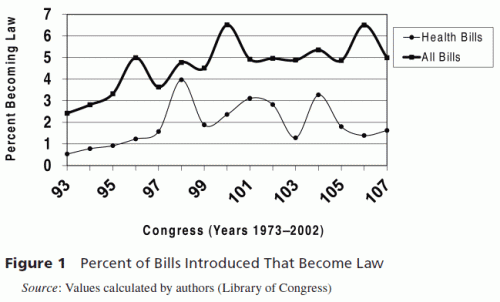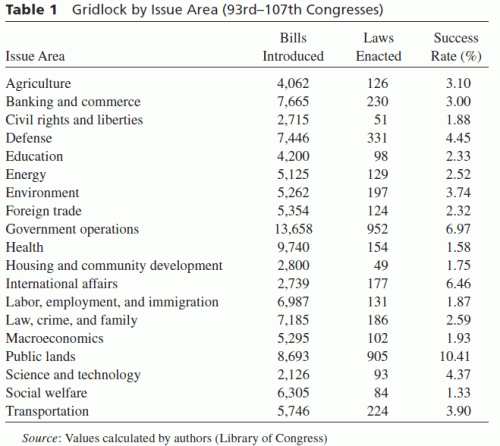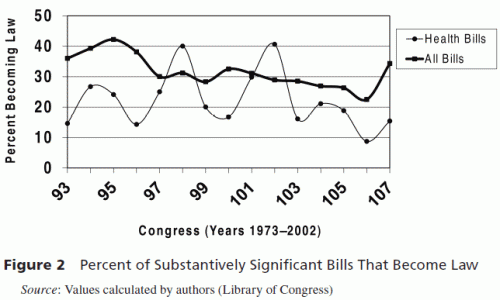by Craig Volden and Alan Wiseman appears in the April, 2011 issue of the Journal of Health Politics, Policy and Law. They ask two related questions:
- Is there evidence of legislative gridlock in Congress?
- Is it worse for health policy, as compared to other types of bills?
In addressing these questions, they lay out a variety of hypotheses that political scientists and others have advanced for why gridlock exists, why it might be worse in the health policy realm, and why gridlock may at times be overcome; none of this will be new to anyone reading this blog. The innovation and value-added from this paper is the empirical work they have done to provide an answer to these questions. In short, they show that most bills introduced do not become law, but that health policy bills are even less likely to become law than are bills that focus on other topics. There were 9,740 health policy related bills introduced into the U.S. House from 1973-2002 (8.2% of the over 119,000 total bills introduced), and they were always less likely to be become law than were bills focused on other areas. The authors take the low passage rate of bills introduced to be evidence of gridlock, and demonstrate clearly that the passage rate is lower for health policy, as compared to other types of bills (see Figure 1 below):
Table 1 shows that the rate of bill passage by topic area ranged from Social Welfare (1.33% pass rate; health policy was the second lowest at 1.58%) to the highest pass rate of 10.4% for bills addressing public lands issues over the period 1973-2002.
A sub-analysis of bills judged to be more substantive in nature/represent larger reforms by the researchers found a higher passage rate for all such bills, health policy or otherwise. However, the more substantive health policy bills remained less likely to be passed as compared to bills addressing other topics across the entire period (Figure 2), though there were two Congresses (98th and 102nd) in which that was not true. Toward the end of the time series, it seems as though the rate of passage of the most substantive bills of all types is trending downward, which is evidence of more gridlock as they have defined it (bills not becoming law equals gridlock).
The most interesting aspect of this paper is the large effort they have undertaken to code all of the 119,040 bills introduced into the U.S. House of Representatives from 1973-2002 by type of bill and then further whether the bill was substantively important or more symbolic. The paper argues that many explanations of past health policy legislative failures or successes have relied upon idiosyncratic ‘one off’ explanations that do not take account of the long run of observational data that are available on this question. For example, after the demise of the Clinton Plan in the early 1990s, some offered as an explanation the fact that the proposal was developed primarily in the executive branch and then moved into Congress as the key explanation for its failure. Similarly, as the ACA hung in the balance in early 2010 and seemed like it would not pass, some were saying that President Obama had made a mistake by letting the proposal be first developed in the Congress and therefore had not put his stamp on the bill. Opposite conclusions, using only 2 examples. Looking at a longer run of empirical data provides better information.
There are other details provided in the paper not highlighted in this post, such as the steady increase of the likelihood of a bill reaching the floor of the House from 1973-1984, and the subsequent decline, and there are detailed regression analyses that test specific hypotheses about what increases the likelihood of legislative success that I will cover in another post. However, the paper provides data that paint a general picture of more policy gridlock in the House of Representatives, both in health policy as well as more generally, with non passage of a bill taken as evidence of failure and therefore gridlock. Of course it is an assumption that non-passage of a bill is evidence of a problem; others might say it is evidence of a triumph. And most persons would likely say that some bills are better passed, while others are better defeated. In any event, most bills are presumably viewed as good ideas by those who sponsor them, and most sponsors are disappointed with the outcome of the vast majority of bills they introduce. A follow up post will look at what predicts those bills that beat the odds, and what that might mean for the future of health policy legislation.




